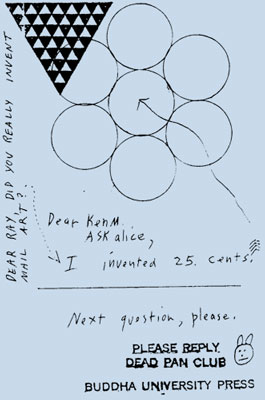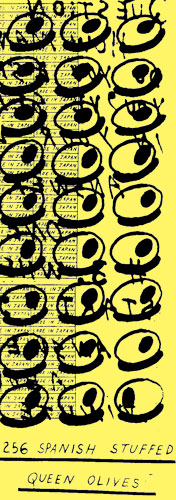
I first heard of mail art while I was in college, at Penn State
University. I heard strange rumors of a group of people who shared
artwork by way of the postal service. Odd, I thought. I had been
participating in this practice for years, creating segmented
postcards with artwork including collage and rubber stamps on the
back (I was obsessed with rubber stamps for some reason). I had never
suspected that there was a name for what I was doing, let alone a
whole group of people who did these things.
For one of my classes, 2D Design, we had an actual mail art
project, to create a piece that was to go into an exhibit, and
eventually into a time capsule which would be opened 100 years in the
future, supposedly. It was kind of a neat idea that sparked my
interests in such pursuits.
A few years later, I started ASKalice, which began as a series of
collages, changed into a T-shirt company and finally a sort of
recording label, before changing into it's current manifestation. I
posted flyers and sent out dozens of postcards to get people to
exchange "collages, drawings, photos, Xerox, etc.", but success
remained elusive. Some artists seemed so attached to their ideas and
artwork that they wouldn't send me any for fear that I would exploit
them for fame and fortune, and others had no concept of what I wanted
them to send me at all. This was going to be harder than I
thought.
I finally found the network, via a guy named Oliver Squash who
puts out his own tapes, and was a rather enthusiastic network
participant. Oliver put up these little slips of paper in music
stores at Penn State. I found one and gave it to my friend Herr
Brine, who sent Squash a tape. To make a long story short, Squash
sent Brine a chain letter, which Brine (after letting it sit around
for six months) sent to me.* It had the address of one
Ashley Parker
Owens, mail art goddess and all around central hub of a large
percentage of networkers. I sent Ms. Owens two stamps and a letter
about my mail art woes. She responded with a postcard that said "the
mail art scene will surprise you beyond your wildest dreams", and she
was right. There was an ever-changing network of people who were
doing exactly what I had wanted to do. The fact that I had remained
ignorant of it for so long led me to believe in the possibility of
any number of other networks, outside of this one.
So how do I define "mail art"?

- It has no set criteria other than it must be sent by
mail.
- Like anything that can be defined as "art", it is a reflection
of our culture, an aesthetic that uses devices associated with
mass production (rubber stamps, Xerox, mass mailings) to convey
it's message, but everything (and I do mean everything) can be
(and is) added to the mix. .
- It is decentralized, in that mail artists all rely on other
artists to convey their messages, their work, their advertisements
for projects.
- It is international, and it goes beyond the usual cultural
barriers of geography and language.
- There is no sanctity of completion; all that is put into it is
subject to further manipulation by other artists: nothing is ever
finished. This is what art is really all about, continual
reinvention and metamorphosis. Paintings in the museums are just
interesting stops along the way, but they are never the end of the
road.
- Because it is freely reproduced and traded, but never sold, it
cannot be compromised for the sake of money.
- It embodies the do-it-yourself spirit that has been absent
from conventional art and music for too long. Anybody can
participate.
- One can take comfort in knowing that no matter what you do,
chances are good that there is someone, somewhere who will like
it.
*The same day I sent out my 10 copies of the chain letter, I won
$5000 in the state lottery. This really happened.

























